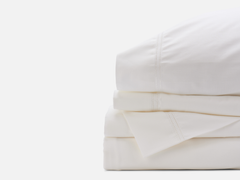It’s starting to get chilly out, but that’s only a problem if you aren’t prepared for it. If you’re taking a cold-weather hike, you won’t have trouble if you’re all bundled up. Likewise, when trying to go to bed, you’ll sleep like a baby if you have enough layers. But layering your winter bedding is about more than just piling blanket after blanket on a bed until you are swimming in your sheets. These tips for layering your bedding for winter will help you build the perfect winter nest.
Materials
When it comes to being warm on a winter’s night, the goal is to control the amount of warmth trapped by your blankets. That means the layers closest to the skin are the most important ones to consider when setting up your perfect winter bed.
In the winter, most people opt for sheets made of a heavier material like fleece or flannel to keep heat concentrated. However, your goal shouldn’t be to keep as much heat as possible next to your skin. After all, even in the winter, it’s possible to wake up in the middle of the night to find that you’re sweating, especially if you have a good heating system in your home.
The key is striking a balance between breathable and warm. Often one of the best bets is to go with a heavier cotton sheet. Our cotton sheet sets made in the USA are made both durable and breathable, to give you a comfortable night’s sleep in the winter months and any month of the year so your bedroom is always cozy.
Triple Sheeting
For another way to add more warmth without creating a sweltering cocoon, add extra sheets instead of just extra blankets. Quality hotels use this trick all the time when they’re setting their beds for guests. They call it “triple sheeting,” just one of many tricks to create the perfect sleep environment.
They start with a base sheet, as usual. Then they add one of the heavier blanket layers before adding another layer of sheets. This results in bedding that is breathable but also traps pockets of warm air, making it warm and comfortable. You’ll transform your bedroom into a country bed and breakfast every time you hit the hay.
Consider Types of Outer Layers
If sheets are like wearing a warm sweater and boots on a winter’s day, then your outer layers of blankets are your winter coat. Anyone who has walked into the bedding section of their local furniture store knows that there are many ways to bundle up at night. You may also have trouble understanding the difference between the types of outer layers for your bed. You want to ensure you pick the right one for you and your bed.
Quilt
A quilt consists of three layers —a top, a bottom, and a batting sewn in between. The top layer usually features ornate patterns and designs that conjure up pleasant, down-home memories. Our 100% cotton quilts are made with cotton batting which doesn’t trap heat like polyester. Instead, our light-weight quilts add warmth without feeling like your suffocating under your quilt.
Comforters and Duvets
Comforters and duvets are similar to quilts, but the difference is the middle layer. Instead of a layer of batting for insulation, they are usually filled with down or other materials. They tend to be “fluffier” than a traditional quilt, and often feature more simplistic stitching patterns and fabric designs.
Although often used interchangeably, there are a few subtle differences between a comforter and a duvet. Duvets usually contain more insulation, making them puffier than comforters, and people generally put them inside of a cover before placing them on a bed. Comforters are usually a little thinner than duvets, and they do not require covers. They also encompass a wider surface area, making them ideal for large beds or tall sleepers.
Layering Outer Blankets
Ultimately, how you choose to layer outer blankets comes down to your sleep and design preferences. Some people prefer the lightweight airiness and modern look of a duvet or comforter. However, once you have breathable sheets, you may want to try placing the heavier weight of a dense blanket on top. Heavier weighted sheets tend to cut down on tossing and turning, making quilts a good choice for the top layer of winter bed. If you’re very sensitive to the cold, you can always use both.
Throw Blankets
As a style choice, adding a knit throw blanket to the base of a bed can add some visual interest to a bedroom. It gives you the option of an extra blanket if you need it without having to completely remove it from your bed if you don’t.
If you find that you get very cold at night though, sometimes adding a blanket to the top of your bedding layers doesn’t make you much warmer. Instead, you should try to put the throw blanket in between the sheets and the outer blanket layers. Blankets are like sweaters: they’re excellent for trapping warmth, but they must be close to the skin to accomplish that. It may take a little longer to tuck a throw blanket under the covers during the night, but the extra effort is worth it.
Heated Mattress Pad
If you’re still cold, you may want to start looking into electric blankets to keep away the winter chills. But electric blankets often short out and carry the risk of causing a fire. A safer option is to buy a heated mattress pad. These go on top of the mattress and under the fitted sheet. Along with being safer, they tend to provide better heat retention than heated blankets, since heat naturally rises. They also come with a variety of settings to help you personalize your night’s sleep.
We strive to prepare our cars, homes, and ourselves for when the seasons change. Why shouldn’t we do the same for our bedding? Keeping warm and getting enough sleep is the best way to stave off pesky winter colds. And with the right bedding layered the right way, you can be sure that you’ll spend your winter night in warm, cozy bliss.











neobest
Thank you for sharing, useful information keep on sharing.